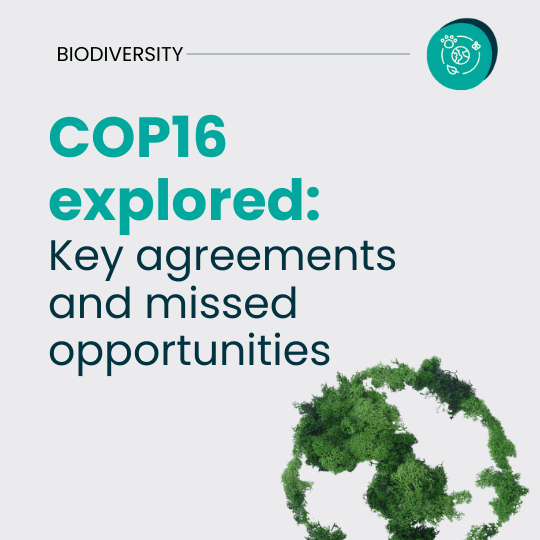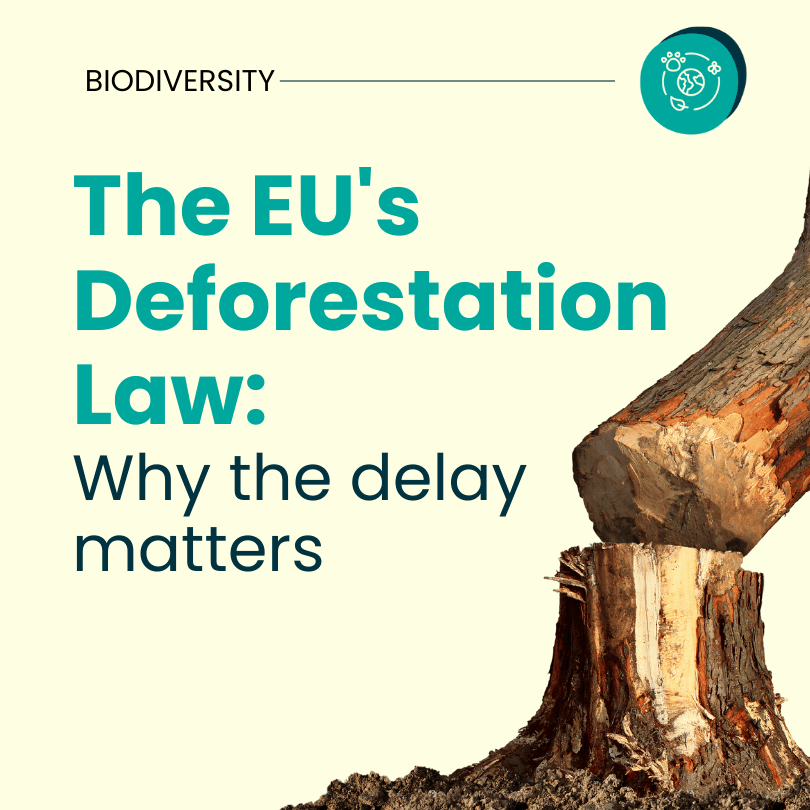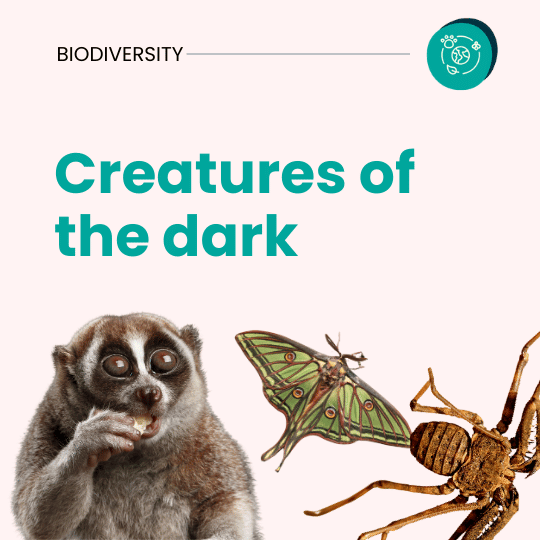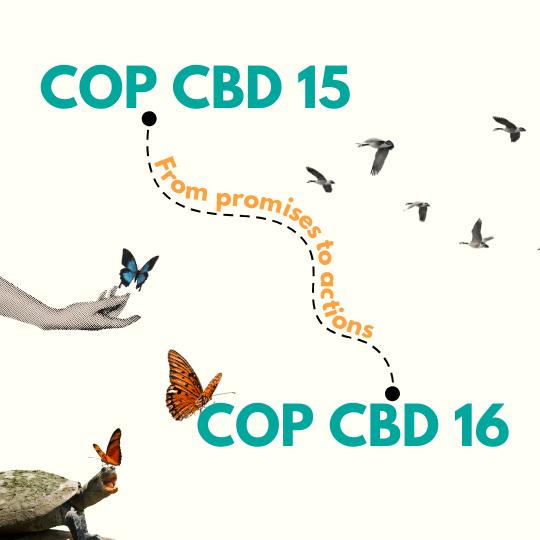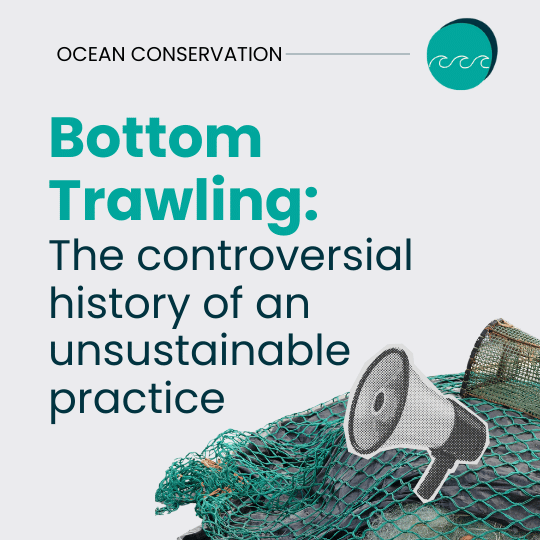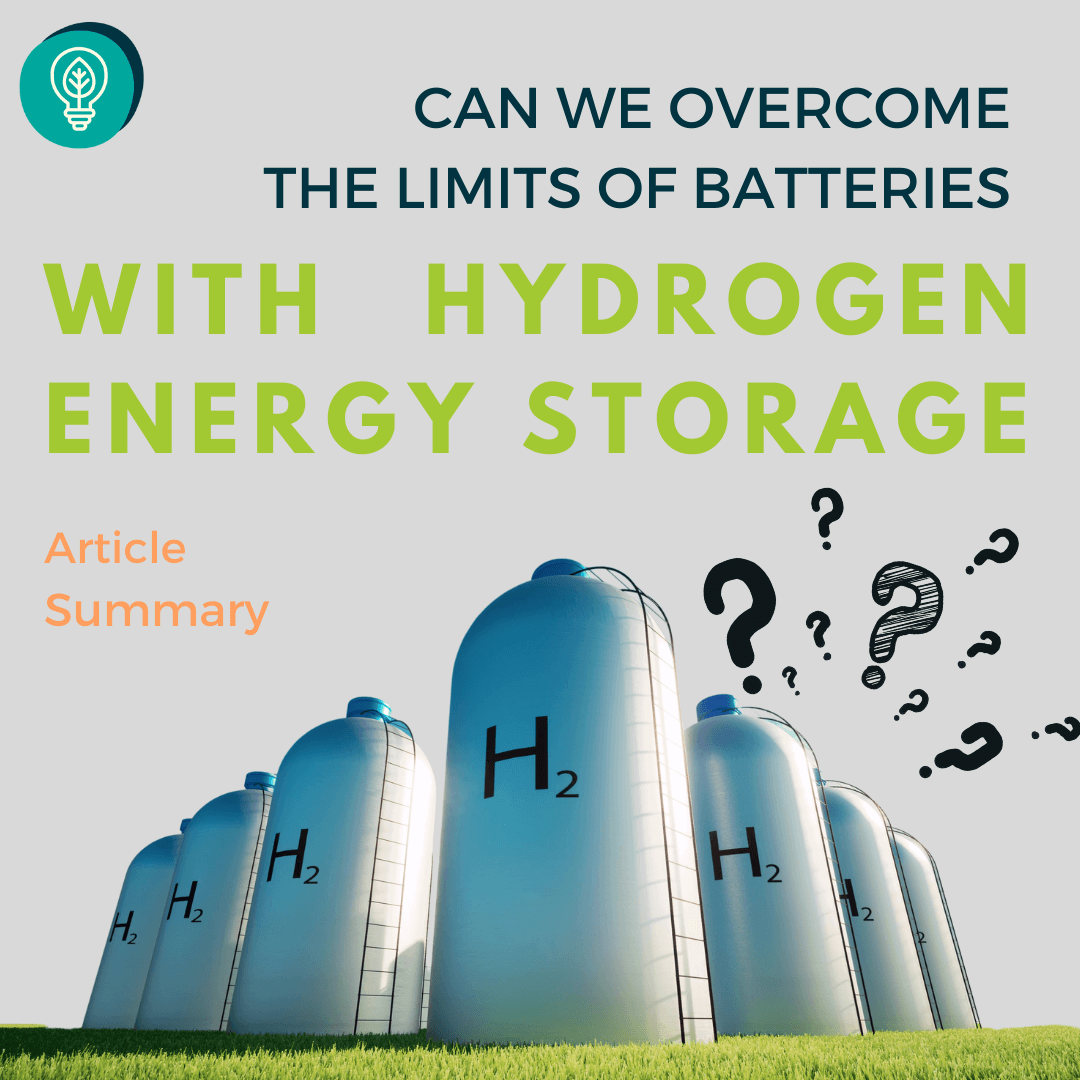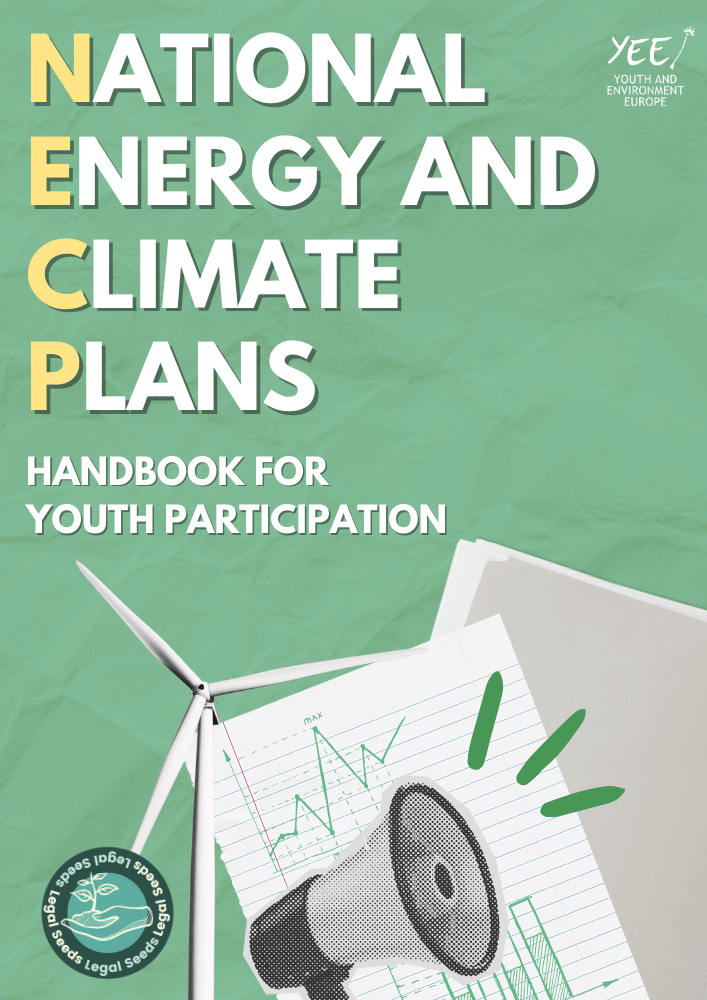
Recommendations to the EU Commission
YEE drafted these recommendations to the EU Commission on how to address the gaps in the exercise of Aarhus rights with regards to European youth. More specifically, the recommendations focus on the absence of youth participation in NECPs processes and its concerning implications, calling the Commission to call Member States to fill this gap as soon as possible and with adequate measures.
These recommendations are complemented by YEE’s country-specific reports on youth participation in the NECP processes in Bulgaria, Cyprus, Greece and Italy.
What is included in the position statement
The Commission should monitor the effective exercise of these rights among Member States, particularly amidst the observed shrinking of civic space, especially among young people and youth organisations. It is imperative to safeguard democratic participation rights among the youth population for more ambitious and effective climate action.
The poor exercise of Aarhus rights among European youth is evident in their non-participation in MCED and consultation processes concerning NECPs revision. Member States’ and EU’s failure to involve younger generations and their representative organisations undermines the rights of those who will bear the consequences of NECPs outcomes well into the future.
“There is a need to provide opportunities to engage in these processes that are specifically designed in such a way that takes into account the needs, opportunities and resources that young people have to engage in the deliberation.”
Learn about other campaigns that YEE supports

As European youth, we hold all relevant decision-makers accountable for this grave backsliding in European conservation law. We call for the return

This document is an invitation to rethink and act, setting ambitious goals for the textile sector that align with biodiversity and climate

As European youth, we acknowledge our region’s historic responsibility for global emissions and call for urgent, just climate action. In solidarity with

As young people in Europe, we expect European countries at COP 16 of the Convention on Biological Diversity (CBD) to prioritise bold,

Put biodiversity on a path to recovery beyond the next funding period to build a safer, healthier future for people and nature.

Youth and Environment Europe and Global Youth Biodiversity Network (GYBN) Europe Advocate for a Complete Ban on Bottom Trawling in Marine Protected

As European youth, we acknowledge our region’s historic responsibility for global emissions and call for urgent, just climate action. In solidarity with young people worldwide, we demand equitable policies that uphold human rights and amplify youth voices, reflecting our duty to a sustainable, inclusive future.

As young people in Europe, we expect European countries at COP 16 of the Convention on Biological Diversity (CBD) to prioritise bold, actionable solutions that address the ongoing catastrophic global biodiversity loss and recognise our continent’s crucial role in addressing the crisis.
More To Explore
Youth Participation in National Energy and Climate Plans
https://yeenet.eu/wp-content/uploads/2024/02/position.png 250 250 Eva Kloudová https://yeenet.eu/wp-content/uploads/2018/11/logo-yee-728x1030.png Eva Kloudová2024-05-30 12:27:042024-05-30 12:50:31Youth Participation in National Energy and Climate PlansThe impact of climate change on terrestrial & freshwater ecosystems
A Wake-Up Call from the European Environment Agency’s debut climate risk assessment
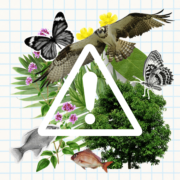
Written by

Ashton Melfor
Contents
Share this article
What is the Climate Risk Assessment?
The Climate Risk Assessment (CRA) by the European Environment Agency (EEA) is a course assessment of the current risks posed by climate change for Europe, for different sectors. The report identifies and analyses 36 risks from the policy perspective and synthesises current scientific consensus on the topic.
The historic decline in habitat quality experienced by Europe’s ecosystems seems to be continuing. This negatively impacts many different species as well as people’s livelihoods. Climate change is already a major player behind these ecosystem changes. However, not all ecosystems are impacted in the same way, and some face other challenges that exacerbate the effects of climate change. Here follows a summary of the climate risk assessment for each of the main terrestrial ecosystems in Europe.
Forests
The CRA makes clear that climate change affects both the structure of forests and their functioning. This influence on forest functioning and structure is both through direct interactions with the forest system and through indirect interactions with other species or drivers of change that do play a direct role in forest systems.
Examples of climate drivers acting on forest systems are temperature and moisture. However, habitat fragmentation caused by deforestation is the primary driver behind forest habitat quality degradation.
Furthermore, a lack of sustainable forestry practices like monocultures also made Europe’s forests more susceptible to pressures from climate change.
Some of these challenges are: drought-induced mortality, species range shift, increased incidence of wildfires and pest outbreaks. Fortunately, the forestry sector has adopted measures to create more climate-resilient forests. Nevertheless, it remains to be seen how impactful these measures are, given uncertainties surrounding forests’ responses to climate change.
Peatlands
The leading cause of peatland degradation is human development conflicting with the habitat requirements of peatlands. The effects of climate change are just exacerbating these already existing mechanisms affecting peatland water balance.
For example, climate-induced drought reinforces peatland drying that is already happening due to peatland drainage. Unfortunately 50% of peatlands in the EU are degraded (25% Europe-wide). This puts many species dependent on peatlands like the bog orchid (Hamarbya paludosa) at risk of going extinct. Very alarmingly, future projections predict that peatland will become a net carbon emitter under current rates of change. This limits their ability to help us mitigate climate change effects. Peatlands are currently a large carbon sink.
Freshwater systems
Freshwater systems are affected by different climate drivers compared to the previous ecosystems. But most importantly, temperature and precipitation contribute to the most change. The consequences of increasing temperatures include shifting thermoclines or more pronounced thermal gradients in water bodies.
Temperature-sensitive species are also at risk as water temperatures rise. Decreases in precipitation can potentially cause water bodies to dry up significantly, but increases in precipitation can lead to toxic algal blooms. The fact is that surface waters are already increasing at a rate of 0.21-0.45°C per decade. This rate of change is particularly high in northern climates. Widespread eutrophication is already a concern in many European countries.
Arctic and mountain ecosystems
The main drivers of change in arctic and mountain systems are rising temperatures and human use. Both systems are particularly susceptible to climate change as they experience faster warming than on average. Additionally, both systems have a long history of human use, from mining and reindeer herding in the Arctic to grazing in mountain grasslands. The current situation of these systems is one of contrasting extremes.
Both droughts and high water retention are becoming commonplace in the Arctic. This destabilises ecosystem function and the ecosystems provided. Mountains are getting less snowfall leading to glaciers receding and lower snowmelt feeding into rivers.
Unfortunately, these threats are projected to worsen with climate change, as the Arctic region warms faster than most places. Leading to the extinction of arctic species, disruption of livelihoods and disappearance of arctic and mountainous ecosystems.
Urban ecosystems
Though climate change puts more pressure on stressors affecting urban ecosystems like the heat island effect, drought and pollution, the impacts are less strong as urban species are more resilient and adaptable.
Nonetheless, increased urban stress still puts the system balance at risk. Conditions might become more favourable for invasive or alien species. Pests and diseases might also be favoured in these changing conditions. Many of these effects are already being felt across European cities, though it is highly context-dependent.
Future projections also show that on the one hand drought in some cities will become more extreme and in others, floods are to be expected. The rise in urban heat island effect in the future is particularly concerning for tree and shrub species already living at their temperature optimums.
Agro-ecosystems
Climate change-induced changes are fortunately not major drivers of change in agro-ecosystems. However, changes in agricultural practices are changing this ecosystem in unprecedented ways. What is certain, is that agro-ecosystems are facing many challenges. Many ecosystem services like pollination, pest control and water regulation are under threat and declining due to many different drivers.
One of the major changes in this system is the sharp decline in pollinators, a combination of agricultural intensification, climate change-induced phenological shifts and pesticide use are disrupting the intricate interactions between insects and plants. In the future climate change will surely become a major driver behind biodiversity loss in agroecosystems. Furthermore, climate impacts soil conditions, with more extreme droughts and soil erosion to be expected.
Conclusion
Not surprisingly, climate change is causing significant changes in terrestrial and aquatic ecosystems. Marine and coastal ecosystems are disproportionately affected by these changes and thus require urgent action. Policy-wise, long-term prioritisation and planning are required to facilitate adaptive management. So how do we move forward? Stronger policy at the EU level is required and in addition, states must work together to tackle our shared risks posed by climate change.
More articles about biodiversity
The impact of climate change on terrestrial & freshwater ecosystems
https://yeenet.eu/wp-content/uploads/2024/05/EEA-climate-risk-report-impact-on-biodiveristy.png 540 540 Eva Kloudová https://yeenet.eu/wp-content/uploads/2018/11/logo-yee-728x1030.png Eva Kloudová2024-04-30 10:02:312024-05-03 14:07:55The impact of climate change on terrestrial & freshwater ecosystemsState of the world’s migratory species
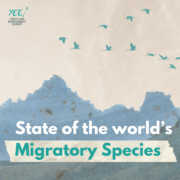
44%, that is the percentage of migratory species listed under the Convention on Migratory Species (CMS) on the path to extinction. The CMS recently published a first of its kind report on the state of the world’s migratory species. This landmark report shows us that we need to take immediate action in order to preserve these amazing animals that know no borders.
Written by

Ashton Melfor

Emilie Tamo Kamguia
Contents
Share this article
What is the CMS?
The Convention on Migratory Species of Wild Animals is a United Nations (UN) treaty. The goal of this treaty is to promote the sustainable use and conservation of migratory species and their habitat throughout the world. Under this treaty governments and wildlife experts must collaborate to address the issues surrounding animals that make migratory journeys on land, in the air and sea. The Convention has 133 members spread across every continent, except North America.
Visual summary
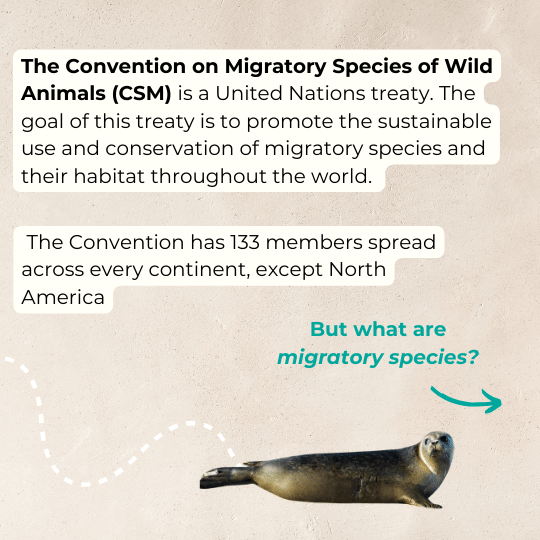
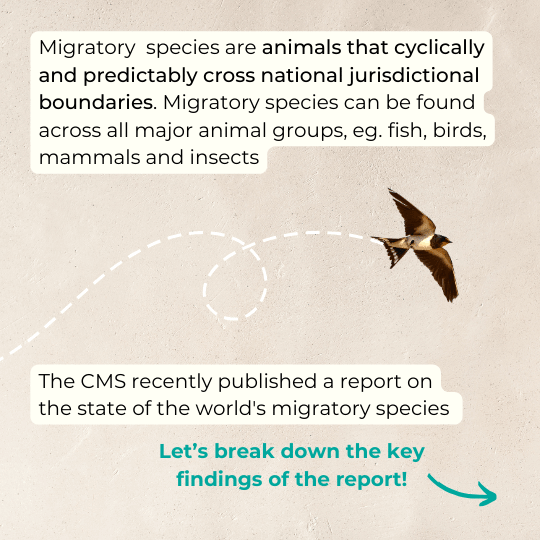
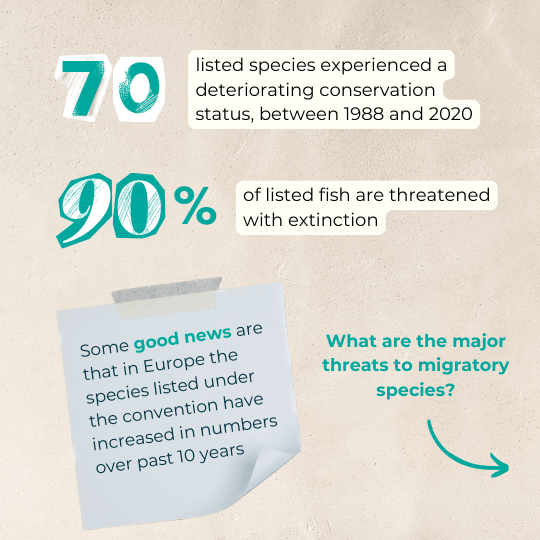
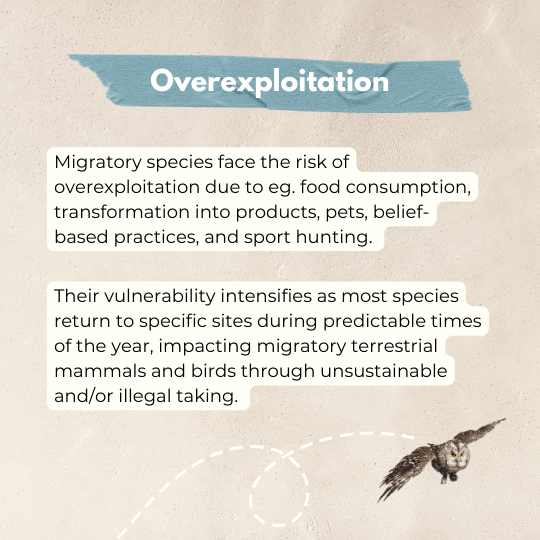
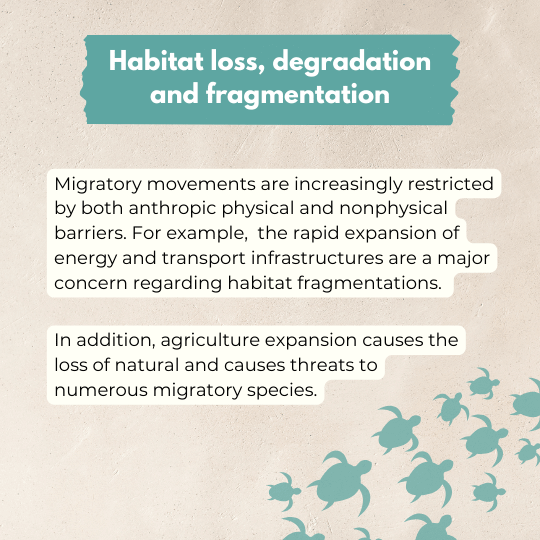





Looking closer at the conservation status of migratory species.
We often hear the words critically endangered, endangered and many more terms thrown around, but what do these terms actually mean for the CMS species being categorised and their conservation?
Let’s explain with an example, the Humpback whale (Megaptera novaeangliae). After a major decline in population size to 450 individuals from 27,000, the western South Atlantic sub-population has reportedly recovered 93 % of its population size. This puts the global population of this majestic creature at around 80,000 individuals. For this reason the Humpback whale is classified as least concern. But the same can not be said for other sub-populations of the Humpback whale. Most are still endangered. So we must be careful when discussing threat level classifications. As global classifications do not always reflect regional or local conservation status of species.
Across the board, the extinction risk is rising for migratory species under the CMS. The report highlights that in the period of 1988 to 2020, 70 listed species experienced a deteriorating conservation status, hence leading to a higher Red List threat category. On the other hand only 14 listed species had a genuinely improving conservation status. Something very important that the report mentions is that, globally 399 migratory species are not listed under the CMS. These species are mostly fish and birds. This is an unfortunate fact as these species can not benefit from CMS protection. They deserve more investigation by the CMS countries and scientists.
Of the species listed under the CMS the future of migratory fish are particularly concerning. 97% of these fish are threatened with extinction. Furthermore, most have a declining population. Compared to fish, mammals and birds are doing a bit better overall. 78% of birds and 44% of mammals have a population of least concern. However, in reality this still means that 134 (14%) birds and 63 (40%) mammal species are still threatened with extinction.
For us here in Europe, there is some good news. As the report says that in the past 10 years, migratory species listed under the CMS in Europe have increased in numbers. Which means a more positive Red List threat status. Fortunately, this is also the case for migratory species in the Caribbean, South and Central American regions.
Revealing threats to migratory species: human activities in the spotlight
Navigating across vast distances, migratory species encounter significant challenges caused by human activities, not only during their journeys but also at pivotal locations for their feeding and reproduction processes. The CMS indicates that 58% of monitored sites, vital for CMS-listed species, are at risk due to anthropogenic reasons.
The report’s in-depth analysis exposes the two most pressing human-induced threats impacting migratory species:
Overexploitation
Migratory species globally face the risk of overexploitation serving various purposes such as food consumption, transformation into products, pets, belief-based practices, and sport hunting. Their vulnerability intensifies as most species return to specific sites during predictable times of the year, impacting migratory terrestrial mammals and birds through unsustainable and/or illegal taking. The oceans, too, witness the consequences of overfishing and the unintended capture of non-target animals, posing a significant challenge to marine migratory species worldwide.
Habitat loss, degradation, and fragmentation
Migratory terrestrial and marine movements are increasingly restricted by both anthropic physical and nonphysical barriers, disrupting vital connectivity for a large range of species. The rapid expansion of energy and transport infrastructures emerges as a major concern regarding habitat fragmentation and its impact on migratory behaviours. In addition, agriculture expansion causing the loss of natural lands and intensification of practices to meet growing human food consumption are key threats to numerous migratory species.
The report reveals other pressures faced by migratory species such as climate change and pollution. These findings highlight the urgent need for immediate intervention to address these threats and ensure the survival of these species and the habitats they depend on.
Unifying efforts to protect migratory species : a wake-up call fo urgent action
After detailing the numerous pressures confronting migratory species, the CMS issues a clear call to immediate, collaborative and international action. Governments, communities, the private sector, and other stakeholders are urged to come together to ensure the survival of migratory species.
While the State of the World’s Migratory Species report presents a concerning scenario, it also highlights successful conservation efforts and policy changes from local to international, demonstrating that viable solutions exist. Achievements include multilateral initiatives to tackle illegal taking of migratory birds and the establishment of international task forces like the CMS Energy Task Force, aiming to reduce renewable energy projects impacts on migratory species. However the report emphasises the need to amplify and expand these efforts globally to achieve conservation objectives.
To combat overexploitation of migratory species, the report’s priority recommendations for action include implementing stricter national legislation, improving monitoring of legal developments, and reinforcing initiatives to tackle illegal, unsustainable taking along with mitigating incidental catch. Addressing habitat loss, degradation and fragmentation requires additional identification and effective protection of crucial sites for migratory species, getting further knowledge on the threats they face, ensuring their ecological connectivity and restoring them when necessary. Urgent attention should be directed towards nearly extinct species, especially CMS-listed fish species. Proposals also include completing the CMS listings with overlooked endangered migratory species, demanding national and international attention. The report finally advocates for implementing ambitious initiatives to tackle climate change and light pollution.
The alarming decline of migratory species populations and broader biodiversity loss due to numerous anthropic threats raises an urgent imperative: a collective and global acceleration of efforts to ensure their future existence is necessary. The CMS, serving as a worldwide cooperation platform, plays a critical role in providing solutions and mobilising forces at every level.
As youth we also have a role to play. Whether we are volunteering for local environmental organisations, advocating for the environment or getting involved in political discussions our voice can stimulate change!
More articles on Biodiversity
State of the world’s migratory species
https://yeenet.eu/wp-content/uploads/2024/03/State-of-the-worlds-Migratory-Species.png 540 540 Eva Kloudová https://yeenet.eu/wp-content/uploads/2018/11/logo-yee-728x1030.png Eva Kloudová2024-03-15 10:19:262024-03-18 12:32:24State of the world’s migratory species
EU Marine Action Plan
More than a year since the EU Marine Action Plan was adopted, there is a critical need to ensure that both the European Commission and Member States are held accountable for its effective implementation. The success or failure of this initiative will hinge upon the national roadmaps to be submitted by each Member State by the end of March. The publication of these national roadmaps will be closely monitored, especially considering the tendency of Member State governments to oppose ocean protection matters, often favouring economic interests over environmental ones. This also became evident in the disappointing response of the European Parliament (EP) to the Communication, which rejected the majority of its content.
Youth and Environment Europe strongly supports the gradual phasing out of bottom trawling in all marine protected areas (MPAs) by 2030 as proposed in the Marine Action Plan. This would be in line with an agreement made between 196 countries, including the EU, during the Conference of the Parties to the UN Convention on Biological Diversity (COP15) to reach a 30% target of protected land and oceans by 2030 in a landmark agreement for the protection of biodiversity. The method of bottom trawling is notorious for its detrimental impact on marine ecosystems due to several reasons, one of which is significant by-catch, such as marine mammals, seabirds, and other fish species. Bottom trawling can also cause extensive damage to sensitive habitats, disrupting the balance of marine ecosystems and damaging biodiversity. Not least because of the use of bottom trawling, European seas are in a severe environmental crisis. The European Environment Agency recently reported that “almost all marine species groups appear to be in bad condition throughout Europe’s seas, with mixed recovery trends”.
The Parliament had a chance to advocate strongly for ocean conservation shortly before the elections and urge the EU Member States to align its fisheries with nature protection policies. They missed this opportunity: Their report on the Marine Action Plan takes a concerning stance towards the use of harmful fishing equipment, suggesting to continue using bottom trawling within MPAs. The European People’s Party (EPP) holds the view that the proposed ban of bottom trawling in MPAs puts the future of fishermen at risk, labelling the Action Plan “discriminatory”. While coastal communities and the impact of the Marine Action Plan on fishers must not be ignored, YEE believes that this pure focus on the economic impact is too short-sighted. The livelihoods of coastal communities ultimately depend on seas with good environmental status and healthy fish stocks, which can simply not be reconciled with the practice of bottom trawling in MPAs. We need cross-cutting and forward-thinking policymaking to address economic concerns in the fisheries sector alongside the climate and nature crises, including support to fishers in transitioning away from destructive fishing gear to minimise negative socio-economic effects.
As Youth Environment Europe, we call upon all EU Member States to commit promptly and effectively to implementation of the Marine Action Plan, and urge the Commission to conduct and publicly release science-based assessments of their national roadmaps. Furthermore, we demand that any identified weaknesses be addressed by Member States, and call for close monitoring and enforcement to ensure their timely implementation. Only through concerted effort and accountability can meaningful progress be made towards safeguarding our marine environment for future generations.
Help us spread the word! Share this statement
More To Explore
EU Marine Action Plan
https://yeenet.eu/wp-content/uploads/2024/02/position.png 250 250 Eva Kloudová https://yeenet.eu/wp-content/uploads/2018/11/logo-yee-728x1030.png Eva Kloudová2024-03-06 14:45:302024-05-30 12:00:43EU Marine Action PlanNature Restoration Law: Youth needs your support

On behalf of European youth, we are reaching out to you as a coalition of youth organizations representing more than 20 million young Europeans with the European environment at heart. On Tuesday the 27th of February, the European Parliament plenary meeting will take place in Strasbourg. We want to underscore the absolute necessity to vote in favor of the provisional agreement on the Nature Restoration Law, for our future, and the future of our and your children.
As young people, we are inheriting a degrading environment and climate which makes us currently see a gloomy future ahead of us. Every day, we witness more species becoming extinct and ecosystems continuing to degrade. It is proof that existing measures so far have been critically insufficient. We are even more worried due to the recent and ongoing watering down of environmental policies and laws at the EU and national level.
This EU Nature Restoration Law is the only opportunity for us to get the chance to see nature improving across Europe and benefit from a healthy environment and climate.
Opposing or further weakening the law would mean condemning our future and fully ignoring all the good things that nature brings to our society. It would mean that young people and future generations, the least responsible for the current crises, will have to address environmental emergencies at a great cost and risk. This is extremely unfair from an intergenerational equity perspective.
On Tuesday, you will cast a vote on our future. The outcome will greatly impact generations of Europeans to come, so we need your vote in favor of the Nature Restoration Law.
Help us spread the word! Share this statement





Learn more about the #restorenature campaign
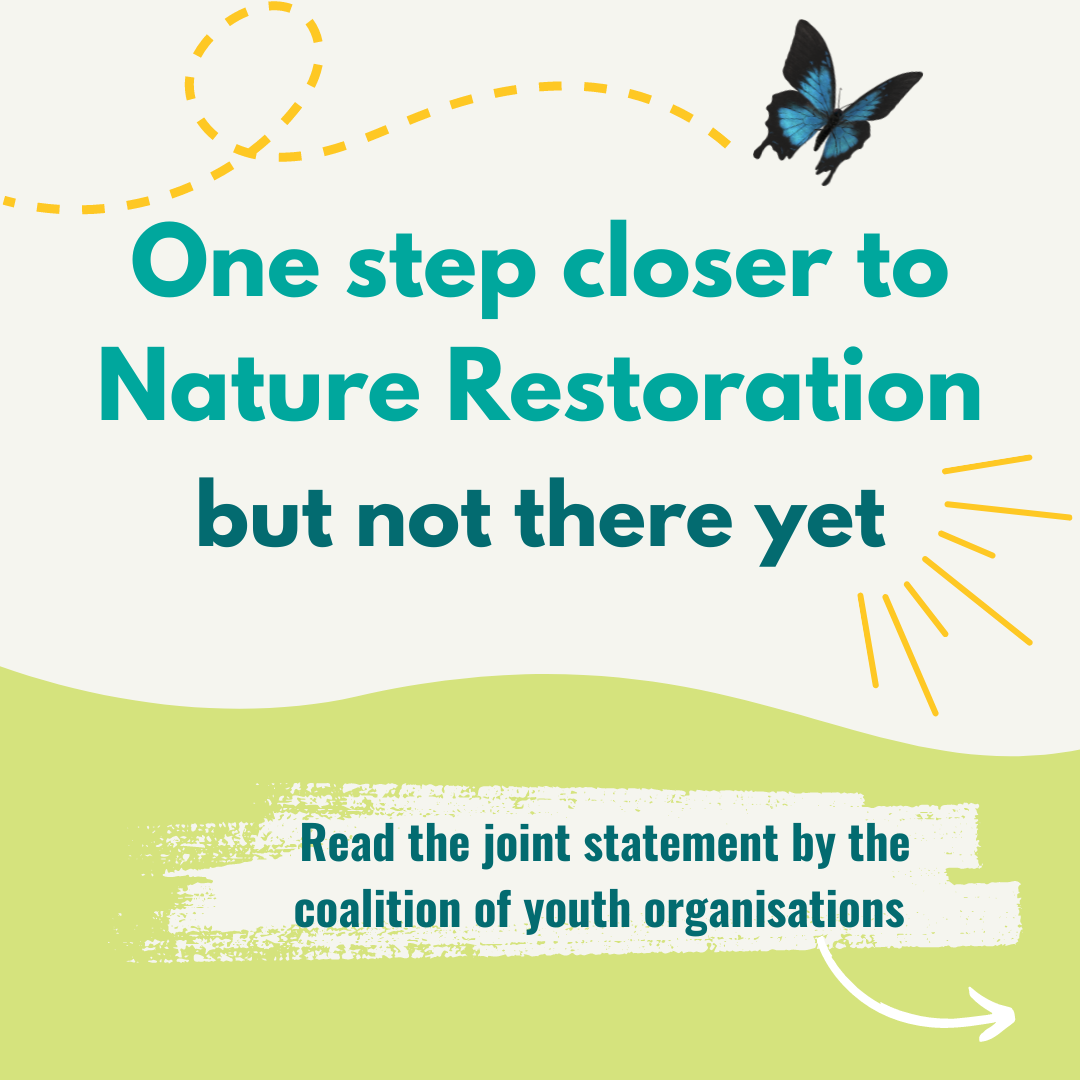
The recent positive vote for the Nature Restoration Law by the European Parliament sends a strong message on the obligation to restore
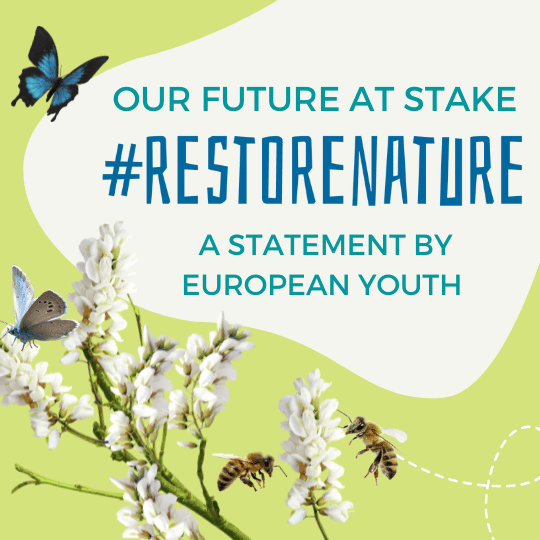
The coalition of youth organisations released their statements about the necessity and urgency to adopt the Nature Restoration Law within the European

Join us and over 200 NGOs and ask your decision-makers to adopt a solid and urgent implementation of the law that can
More To Explore
Nature Restoration Law: Youth needs your support
https://yeenet.eu/wp-content/uploads/2024/02/position.png 250 250 YEE https://yeenet.eu/wp-content/uploads/2018/11/logo-yee-728x1030.png YEE2024-02-26 17:14:232024-02-26 18:39:49Nature Restoration Law: Youth needs your supportWhat are countries doing about plastic pollution?
A reflection of a INC-3 youth delegate.
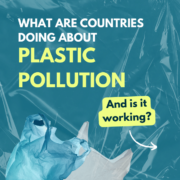
Written by
Shellan Saling
Disclaimer
The views and opinions expressed are those of the author and do not necessarily reflect the official policy or position of YEE.
Contents
Visual summary


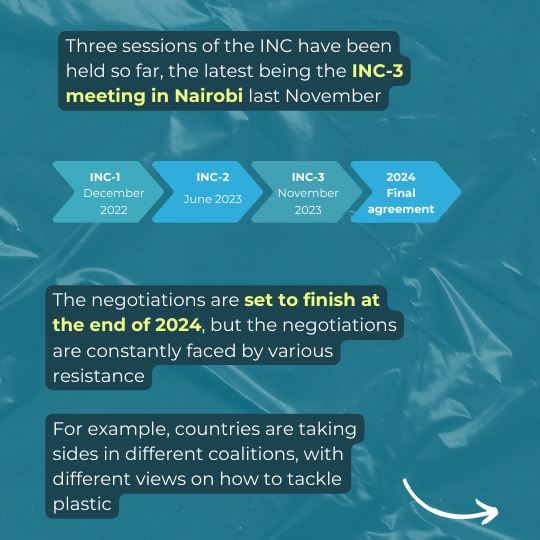







Share this article
The “Nairobi Spirit”
At the United Nations Environmental Assembly (UNEA 5, 2022) at the UNEP headquarters in Nairobi, Kenya Resolution 5/14 entitled “End plastic pollution: Towards an international legally binding instrument” was passed to start the process of the plastic pollution treaty.
This historic moment marked the beginning of what several major news organisations have called the most important environmental deal in all fields since the 2015 Paris Climate Agreement. This paved the way for the establishment of the Intergovernmental Negotiating Committee on Plastic Pollution (INC) to develop “the instrument”, which is to be based on a comprehensive approach that addresses the full life cycle of plastic, including its production, design, and disposal” (UNEP) (See timeline below).
Five rounds of negotiations (INC) have been proposed for countries to come to an agreement and close negotiations by the end of 2024. This treaty will be the first-ever global agreement on addressing plastic pollution and aims to tackle the full life-cycle of plastic.
Plastics are currently one of the last unregulated industries contributing to the climate crisis and increased carbon emissions. Currently, 430 million metric tons of plastics are produced every year and without intervention, this could triple by 2060. The majority of plastic is neither recycled nor reused (UNDP). It follows that a plastics treaty is not only necessary for human health but also for future generations. This statistic was emphasized in the most recent negotiations (INC-3) in Nairobi, Kenya in November 2023.
Timeline of the INC Process
The third round (INC-3) was held from 13 to 19 November 2023 at the UN Environment Programme (UNEP) Headquarters in Nairobi, Kenya. After countries voted to create a Zero Draft at INC-2. The Zero Draft was a collection of ideas and views from member states submitted during the international negotiations in INC-2. The draft was released during the inter-sessional period between INC-2 and INC-3, when countries began negotiating the Zero Draft version of the treaty. During a preparatory meeting for INC-3 on November 11th, Iran announced a low-ambition coalition with other gas-driven countries called the Global Coalition for Plastics Sustainability. There was very little to no mention of the coalition during the rest of the negotiations. Countries negotiated a specific text in three smaller groups called contact groups. Each group debated the following parts of the treaty:
Contact group 1: Part I and Part II of the Zero Draft
Contact group 2: Part III and IV
Contact group 3: Addressed elements not previously covered at previous INCs including principles, scope, and definitions.
While negotiations progressed throughout the week, the “Nairobi Spirit” died at the very last minute late on the last night of negotiations after contact group 3 could not come to a consensus on important intersessional work due to be completed between INC-3 and INC-4. Low-ambitious countries successfully used stalling tactics to threaten an ambitious treaty being drafted by the end of 2024 and aimed to be in place by 2025. While countries are eager to work and close negotiations by the end of 2024, there appear to be a lot of ideas for the treaty which are ultimately hindering progress.
More ideas than agreements after INC-3
The negotiations ended with more ideas than conclusions. During INC-3 the secretariat received over five hundred submissions from member states on the treaty. Due to the number of submissions at one point, some member states were arguing that their voices and inputs were not being heard. This led to threats by some states to quit negotiations.
The result was a revised draft expanded from thirty-one pages released after INC-2 to 71 pages. Some sections such as the scope have sixteen different options on text while several other options have four or more options. This was instead of a first draft that was expected after INC-3, a revised zero draft was released on December 26, 2023.
Low-ambitious, gas-driven countries such as Iran, Russia, and Saudi Arabia are arguing for a treaty focused on recycling, waste management and voluntary action, while other countries that are part of the High Ambition Coalition to End Plastic Pollution, co-chaired by Norway and Rwanda, are arguing for a treaty that focuses on global mandates by aiming at reducing plastic and targeting the full lifecycle of plastics. Along with more ideas, the lack of an agreement on intersessional work resulted in more setbacks.
The consequences of a lack of consensus
The initial timeline proposed important inter-sessional work which, as agreed at INC-2, should have happened between INC-3 and INC-4. This intersessional work was supposed to bring in experts on different technical and scientific topics related to plastics, finance, and implementation issues. Many of these topics would help delegates have a better understanding of what they are discussing and negotiating as well as different perspectives to fill in knowledge gaps.
This would have helped advance negotiations further at the upcoming INCs. At the last minute, the United States tried to reopen negotiations with Brazil agreeing to try to come to a consensus on work for the inter-sessional period (months between INC-3 and INC-4), but Russia and Saudi Arabia struck down the idea. After hearing member states’ opinions, the Chair decided not to reopen negotiations delaying hopes of progress towards an ambitious plastic reduction treaty.
An ambitious treaty threatened by lobbyists
As countries argue the direction of the treaty, several issues externally and internally towards an ambitious treaty remain. The treaty has gained attention from the fossil fuel and chemical industry. According to the Center for International Environmental Law (CIEL), “143 fossil fuel and chemical industry lobbyists have registered to attend the third session of the Intergovernmental Negotiating Committee (INC-3) to advance a global plastics treaty, gaining access to the negotiations at a time when the talks are entering a critical phase”. The article goes on to say this is a 36% increase from previous INCs.
The fossil fuel and chemical industry lobbyists outnumbered the scientist coalition by over 100 people and 70 of the smallest member state delegations, and they will likely increase in the coming INCs. One of the potential solutions to preventing fossil fuel and chemical lobbyists from interfering with the negotiations would be to pass a Conflict of Interest Policy in the upcoming United Nations Environment Assembly (UNEA-6) or future meetings related to the plastics treaty such as the future Conference of Parties (COP). A Conflict of Interest Policy has been requested by several observers. By passing this policy it could prevent a weak treaty.
Lack of representation in the treaty
The treaty continues to lack representation from key groups impacted by plastics and the effects of plastic pollution in the revised Zero Draft text: its seventy-one pages only mention “Indigenous” twenty-eight times, while “youth” and “children” combined are only mentioned ten times. Other vulnerable groups such as women, waste pickers, and workers in plastic value chains are even mentioned less. There are several vulnerable groups not yet mentioned in the treaty such as the disabled (physically and visually-impaired), people of color, and displaced people. Also, the term vulnerable populations/groups remain undefined. This could cause problems during the implementation of the treaty, leaving certain groups at risk of the effects of plastic pollution and unable to benefit from the treaty.
Final thoughts and looking ahead
The UN Plastic Pollution Treaty faces an uphill battle to be completed by the end of 2024. It is still unknown if the treaty will focus more on waste management and recycling or reduction. Several important groups remain voiceless in a treaty critical for their health and livelihoods. The next two INCs are scheduled to be INC 4 in Ottawa, Canada in April and INC 5 in Busan, South Korea in November.
Many key elements of the treaty such as scope, definitions, and principles remain undecided, which will add to the additional challenge of cutting text and cementing a clearer direction the treaty will take. This will make it more challenging for member states to complete the negotiations by the end of 2024. If the treaty stays on schedule, the Diplomatic Conference will be held in 2025 to adopt it and for member states to sign. This would also be when a governing body will be established for future Conference of Parties (COP) to be held on the treaty.
INC-4 will be critical for countries to decide the direction the treaty will take. The secretariat will provide an update in February UNEA-6 on the status of the treaty. While history has shown it is not impossible, it is going to require total focus and compromises from member states to achieve a historic plastics treaty by the end of 2024.
More articles
The war in Ukraine has highlighted the significance of energy policy as a major power issue. It is an opportunity to break
What are countries doing about plastic pollution?
https://yeenet.eu/wp-content/uploads/2024/02/1.png 675 675 Youth and Environment Europe https://yeenet.eu/wp-content/uploads/2018/11/logo-yee-728x1030.png Youth and Environment Europe2024-02-22 17:25:542024-02-23 13:06:00What are countries doing about plastic pollution?Practical information
-
When
Friday 9th February 2024 at 16h CET
-
Where
Online
-
How
Register your interest
Share This Event
Presenters:
Youth and Environment Europe (YEE), World’s Youth for Climate Justice (WYCJ), Auroramålet, Victorine Nagels (lawyer)
Presentation by WYCJ: The World’s Youth for Climate Justice is an international youth-led campaign that aims to bring climate change to the ICJ. Among others, we will discuss how we can all join forces in this last stage before the submission.
Presentation by Auroramålet: Auroramålet represents 300 young people who have sued the Swedish state for insufficient climate action. We will discuss why we have chosen human rights-based climate litigation as a tool for climate justice, and what we have learnt that could make it easier for others to do the same. This talk will cover how we manage legal strategy, funding, communications and advocacy with limited resources.
Presentation by YEE: We will discuss and present what are National Energy and Climate Plans (NECPs), and why it is important for youth to provide feedback and actively participate in them.
Presentation by Victorine Nagels: We will hear from a young lawyer involved in defending young climate activists. Questions for the discussion include: which young people can take legal action and what are the risks? Is the situation different when young people act through an association? What are the situations in which it might be worth taking legal action? What happens when young people have to defend themselves in court?
Have questions? Get in touch!
Other upcoming events
Climate Litigation As a Tool for Youth Climate Movements
https://yeenet.eu/wp-content/uploads/2024/02/CLIMATE-LITIGATION.png 675 675 Eva Kloudová https://yeenet.eu/wp-content/uploads/2018/11/logo-yee-728x1030.png Eva Kloudová2024-02-05 17:20:302024-02-21 16:48:02Climate Litigation As a Tool for Youth Climate MovementsCall for volunteers | AWG
The YEE Advocacy Working Group is the perfect opportunity to become an influential young leader.
7-10 h/ week
EU/Europe
Remote
Start February
Contents
Share This Opportunity
Have questions? Get in touch!
YEE’s Advocacy Working Group is looking for 8 motivated, passionate volunteers to join the team!
About YEE Advocacy Working Group
The Advocacy Working Group (AWG) is a leadership program intended to equip volunteers with the necessary skills, knowledge, and mentorship to effectively advocate for environmental concerns during their tenure with YEE, and beyond. Volunteers are being mentored and engaging in peer-to-peer learning; while supporting the Advocacy Team in shaping YEE’s external advocacy positions.
What will you get:
This volunteer position offers valuable insights into working for a large European network of youth-led environmental NGOs, as well as in-depth knowledge of relevant organisations and institutions.
It also provides access to a network of young green activists and professionals and helps develop transferable skills such as time management, organization, and communication, which can boost your CV.
About Liasion Officers (LOs)
The Liaison Officer is a volunteer position of one year term (January 2024 – January 2025). All liaison volunteers will report to and be supported by the YEE Advocacy staff and the External Relations Officer. While committed to specific and diverse tasks within their thematic portfolios, the volunteer liaison officers would effectively make a team – the Advocacy Working Group – intended to support each other. The average commitment would be between 7-10 hours a week, including meetings every two weeks.
Some of the work tasks expected include strengthening communication and advocacy with our partner organisations as well as creating projects and campaigns of their own.
About Regional Contact Persons (RCPs)
The role of the RCPs is to connect and develop communities of YEE’s member organisations on the regional level and work together to strengthen the connections of young people through YEE.
They act as the point of contact between YEE and the member organisations in their region, hosting meetings for the representatives of the member organisations, and linking them with any relevant projects and opportunities from YEE. They also work to strengthen YEE’s presence in and knowledge of their region, contributing with invaluable information for our expanding network.
Application deadline: 28th January 2024
Volunteering positions available
The Liaison Officers on Biodiversity will work in a small team composed of 2 Liaison Officers and the Biodiversity Manager. The aim of the portfolio is twofold. On the one hand, we aim at building capacity on pressing biodiversity issues through a series of workshops and the publication of easily accessible knowledge materials, potentially in collaboration with our Member Organisations (MOs). On the other hand, the LOs will follow first hand the biodiversity advocacy initiatives we are pursuing together with other youth NGOs, such as GYBN, GCE and EU Young Rewilders, and NGOs we are members of, such as CAN-E.
One of the most important examples of such collaboration is the #restorenature campaign.
The LOs will also be the contact persons for the CoE Bern Convention, YEE is an observer of.
The main tasks will include:
- 🟢 Help our members to engage with our work on biodiversity, through liaising and working on our relationship with MOs and partner organisations (e.g. working on our newsletter and organising collaborative events);
- 🟢 Work on content creation, such as articles and explainers;
- 🟢 Represent YEE at the Bern Convention processes (either online or onsite, pending fundings);
- 🟢 Contribute to the YEE’s biodiversity advocacy strategy, such as through participating on behalf of YEE to legal campaigns and external events.
- 🟢 Follow the opportunities stemming from our membership to IUCN (tbc, pending approval of application).
The primary role of the Liaison Officer on Climate Justice will be to continue and strengthen YEE’s engagement in UNFCCC processes, in which YEE holds observer status, throughout the year. The Liaison Officer will carry out research and gain expertise on selected UNFCCC negotiation items of interest to them (such as Loss & Damage, Finance, Art 6, Action for Climate Empowerment, or others), engage with our MOs and other youth organisations who are active in UNFCCC processes and/or on the topic of climate change (including NEYCA – the Network of European Youth NGOs for Climate Action), and work to build stronger connections with marginalised persons and organisations active in climate advocacy, particularly those based in the so-called Global South. Great part of this collaboration will be undertaken under the project “Global Dialogues for Climate Justice”, YEE is implementing with our partner WAT-GP.
The main tasks will include:
- 🟢 Engaging with our MOs active on climate issues, NEYCA, YOUNGO, CAN-E, and other key partners to strengthen our participation in UNFCCC processes;
- 🟢 Leading joint campaigns and drafting joint position papers in the run-up to UNFCCC processes;
- 🟢 Contributing to the Global Dialogues for Climate Justice project, co-led by YEE and We Are Tomorrow Global Partnership (WAT-GP), which aims at building stronger connections between European and non-European youth with a view to advocating for climate justice at COP29;
- 🟢 Leading strategic outreach to marginalised youth communities and youth organisations based in so-called Global South countries working on climate-related topics.
The Liaison Officer on Intersectionality will help the AWG keep a critical, intersectional perspective in all of its projects as well as to create events and campaigns that concern environmental synergies with gender, class, racial, disability and sexuality questions. This would also involve reaching out to and collaborating with organisations YEE may not yet be linked to that pioneer youth work in these areas. Moreover, the LO could choose to incorporate increased work with European Neighbourhood countries.
Key Themes and Questions for the Intersectionality Liaison Officer:
- How do environmental questions intersect with:
- Race and ethnicity
- Gender and the livelihood of women
- LGBTQ+, the topic of queer ecology
- Disability issues, accessibility and ableism
- Class disparities
- Regional disparities and privilege
The main tasks will include:
- 🟢 Support the project lead of Empowering the Unheard in organising workshops on intersectional justice;
- 🟢 Produce toolkits and other material to disseminate knowledge on intersectionality & climate change;
- 🟢 Assist and work on partnership connections and links to further promote YEE efforts;
- 🟢 Assist in the planning and execution of a social campaign for Empowering the Unheard.
The LOs on Environmental Policy will follow first hand YEE’s external advocacy, at EU and at International level. The portfolio aims at strengthening YEE’s advocacy on UN environmental governance and at empowering young people to understand and have an active role in the EU parliamentary elections 2024.
For the first time, we are recruiting two volunteers, one on EU and one on international affairs: however, their work is complementary and they will work together in a small team.
Environmental Policy – EU Affairs (1 person)
The main tasks will include:
- 🟢 Take over and develop YEE’s advocacy work towards (and beyond) the EU Parliamentary Elections 2024, including
- Strengthen collaborations with the EEB and other key partners
- Develop YEE’s strategy for the upcoming elections
- Coordinate a communication campaign with YEE’s member organisation with 2 main objectives:
- Advertise concrete local actions of the EU “What has the EU done for you?”
- Call upon young people to go and vote on election day
- Organise meetings and/or workshops with key EU representatives and leaders to ensure youth voice is heard
- 🟢 Cover EU parliamentary actions after the election (i.e Appointment of the President of the European Commission, selection of the commissioners, future of the EU Green Deal etc.)
- 🟢 Strengthen collaboration and work with EESC and its youth representative
Environmental Policy – International Affairs (1 person)
The main tasks will include:
- 🟢 Represent YEE in the MGCY;
- 🟢 Ensure strong commitment and participation to UN environmental meetings (e.g. UNEA);
- 🟢 Contribute to the organisation of the RCOY Europe 2024, together with other NGOs YEE is already collaborating with;
- 🟢 Collaborate with the Climate Justice LO to co-represent YEE in the NEYCA on drafting the EU youth NGOs position paper for COP29 and other international fora.
We are looking for three volunteers to join us in the mandate of RCP for the South (currently spanning organisations from Albania, Bosnia and Herzegovina, Slovenia, Italy, Kosovo, Portugal, Serbia, Spain and Turkey), North (currently spanning organisations from Sweden, Ireland and England) and East (currently spanning organisations in Armenia, Azerbaijan, Bulgaria, Czechia, Georgia, Moldova, Poland and Romania) region.
Your tasks will include:
- 🟢 Collaborating closely with the regional team, the Member Organisations Officer and the Member Organisations Coordinator to plan, enhance and implement our regional strategy;
- 🟢 Organising and chairing online regional meetings with member organisations of your area four times a year;
- 🟢 Keeping the Membership Officer informed about the situation in your region on a regular basis;
- 🟢 Contributing to the written Annual Regional Report about the status of your region;
- 🟢 Stimulating and supporting member engagement in YEE activities and projects;
- 🟢 Reaching out to and enhancing collaboration with youth movements in your region.
RCPs specific requirement: live in the region they are applying to become an RCP for (however, nationality doesn’t matter)
Requirements
- have strong written and verbal communication skills and a good level of English
- have basic computer skills (Microsoft Office, Google Drive)
- be available around 7-10 hours per week
- be between 18 and 30 years old
- Be aligned with YEE's core values and mission
- have a strong interest in advocacy and promoting sustainable policy and green goals
- be passionate about helping strengthen the voice of youth in European decision-making
- have a good team spirit and be able to be part of a brand-new team
- be organised and meet deadlines
- be willing to extend your leadership and communications skills
Call for volunteers | AWG
https://yeenet.eu/wp-content/uploads/2018/11/logo-yee-728x1030.png 0 0 YEE https://yeenet.eu/wp-content/uploads/2018/11/logo-yee-728x1030.png YEE2024-01-09 15:37:392024-02-21 16:46:54Call for volunteers | AWGPractical information
Share This Event
Are you interested in a campaign to mobilise youth in the NECPs processes?
During the session, attendees will have the opportunity to learn more about the campaign and how they can get involved. The YEE Environmental Law team will provide an overview of the NECPs processes and explain how young people can participate in them.
About NECPs
NECPs, or National Energy and Climate Plans, are an important part of the EU’s efforts to combat climate change. They set out each member state’s targets and policies for reducing greenhouse gas emissions, increasing renewable energy, and improving energy efficiency.
Have questions? Get in touch!
Other upcoming events
National Energy & Climate Plans | Webinar
https://yeenet.eu/wp-content/uploads/2024/01/National-Energy-and-Climate-Plans.png 1080 1080 YEE https://yeenet.eu/wp-content/uploads/2018/11/logo-yee-728x1030.png YEE2024-01-09 13:59:232024-01-26 11:54:50National Energy & Climate Plans | Webinar
National Energy and Climate Plans | A handbook for youth participation
This handbook works as an explainer to the EU regulated National Energy and Climate Plans, and as a guide to how to participate in the process as a young citizen.
Each EU Member State is required to submit a National Energy and Climate Plan (NECPs), reflecting how various energy and climate targets will be achieved. According to EU regulations, these plans need to be open to public participation and consultation, yet the majority of Member States have failed to provide opportunities for the public to participate in the process.
These handbooks aim to shed light on the ways in which public participation can be improved, and how you as a young person can take part in the process!
This toolkit covers:
-
Explaining NECPs
National Energy and Climate Plans (NECPS) are plans that each Member State of the European Union needs to prepare. An NECP should reflect how energy and climate targets will be achieved. But what does this mean in practice? What kind of information do NECPs contain?
-
Exploring the role of public participation
According to EU regulations, all NECPs should be open to public participation and consultation. What is so crucial? And are all Member States fulfilling this requirement?
-
What we as young people can do
Including the perspective of young people is important for well-functioning NECPs, but participation is not always easy. How can you as a young person take part in drafting NECPs? How can you make your voice heard?
Youth Participation in the NECPs
The Legal Seeds project has been conducting interviews with young people from 4 different EU member states, in order to report on the status of youth participation in the NECP-process. We have compiled country-specific reports on youth involvement for Cyprus, Italy, Bulgaria (coming soon) and Greece (coming soon). These reports outline both the importance and legal requirements of public- and youth participation, while describing the current status of youth involvement in the NECP-process. These reports also highlight the shortcoming of the national processes, while also including suggestions on improvements to national governments.
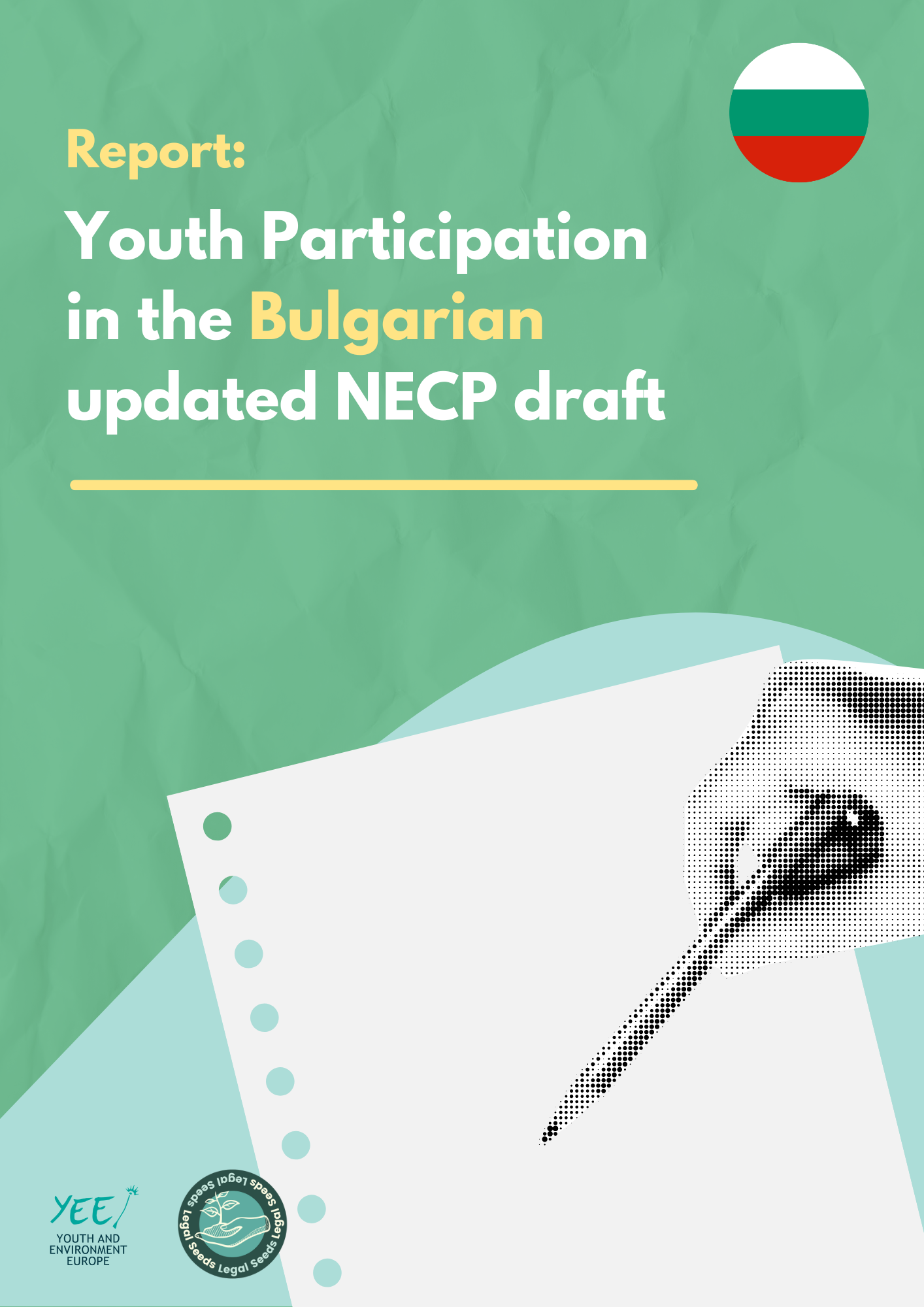
Youth Participation in the Bulgarian updated NECP draft
In Bulgaria, youth participation is often seen as a “good to have” addition to the already minimal requirements for participation put in place. However, youth empowerment is growing and is demanding more and more accountability, transparency and engagement from public institutions.
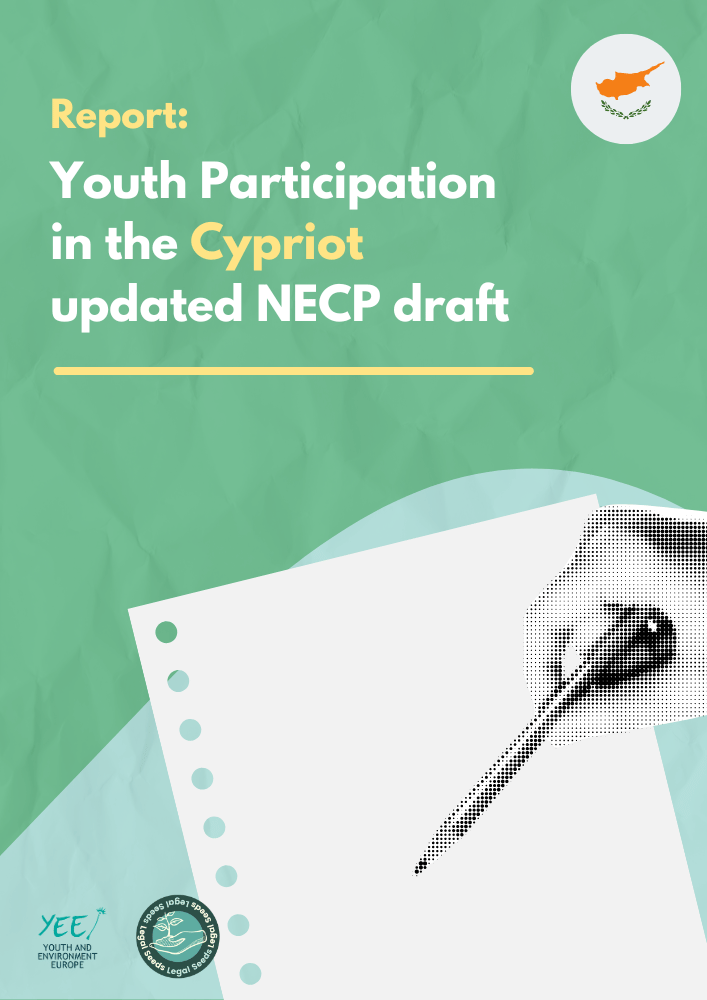
Youth Participation in the Cypriot updated NECP draft
The report raises awareness about Governance Regulation shortcomings in Cyprus, focusing on updating NECPs in 2022/2023. Public participation is not there solely for the sake of participating - it is there to increase the acceptability of divisive policies and unite the Cypriot public.
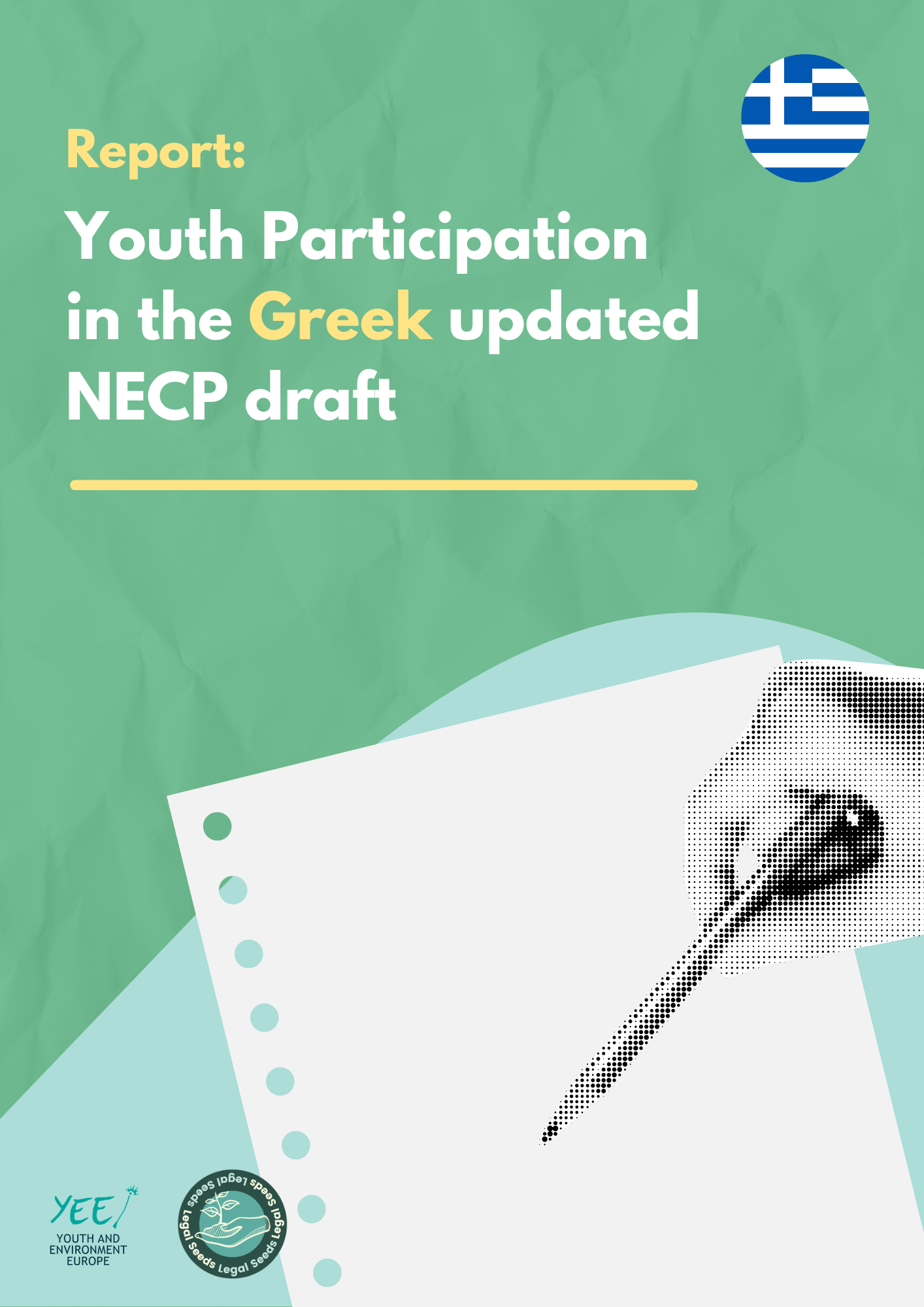
Youth Participation in the Greek updated NECP draft
Young individuals in Greece perceive significant neglect in the National Energy and Climate Plans (NECPs). The overall process of engaging in NECPs has been disappointing, failing to meet the state's obligations under the Governance Regulation.
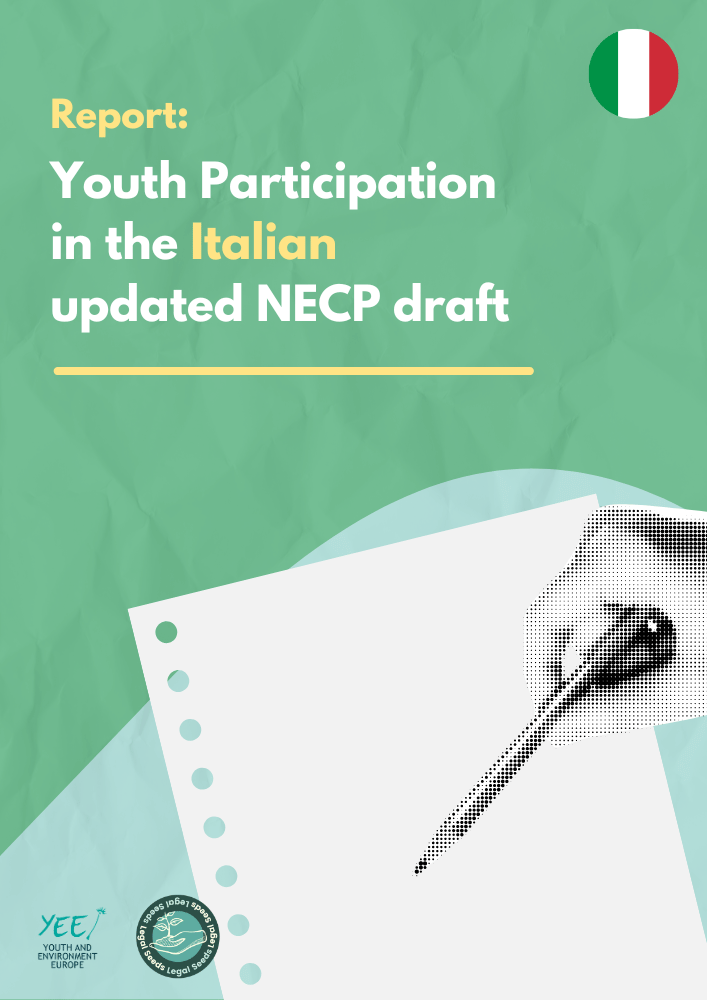
Youth Participation in the Italian updated NECP draft
The report highlights issues with implementing the Governance Regulation in Italy, focusing on updating National Energy and Climate Plans (NECPs), namely the lack of public participation in Italian climate and environmental policymaking , higlighting the bigger focus on administrative procedures rather than human rights.
National Energy and Climate Plans | A handbook for youth participation
https://yeenet.eu/wp-content/uploads/2024/10/National-Energy-and-Climate-Plans-featured-image.png 540 540 YEE https://yeenet.eu/wp-content/uploads/2018/11/logo-yee-728x1030.png YEE2023-12-19 13:56:302024-10-02 15:40:08National Energy and Climate Plans | A handbook for youth participationOur mission
 YEE aims to unite environmental youth non-profit organisations in Europe in order to enhance international cooperation, increase knowledge about the climate crisis, raise awareness of environmental problems and to strengthen participation of youth in environmental decision-making.
YEE aims to unite environmental youth non-profit organisations in Europe in order to enhance international cooperation, increase knowledge about the climate crisis, raise awareness of environmental problems and to strengthen participation of youth in environmental decision-making.
Get in touch
Vinohradská 2165/48
120 00 Praha 2 – Vinohrady
Czech Republic
E-mail: yee@yeenet.eu


Financially supported by the European Youth Foundation of the Council of Europe. The views expressed do not necessarily reflect the official position of the Council of Europe





